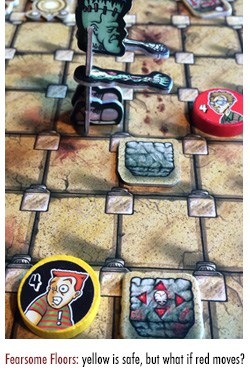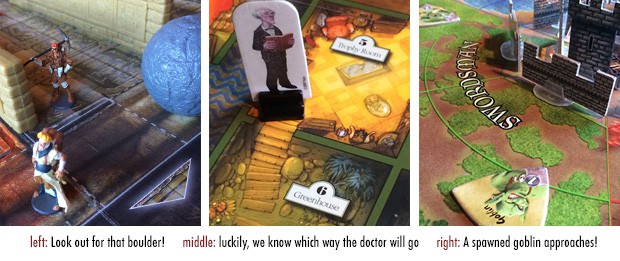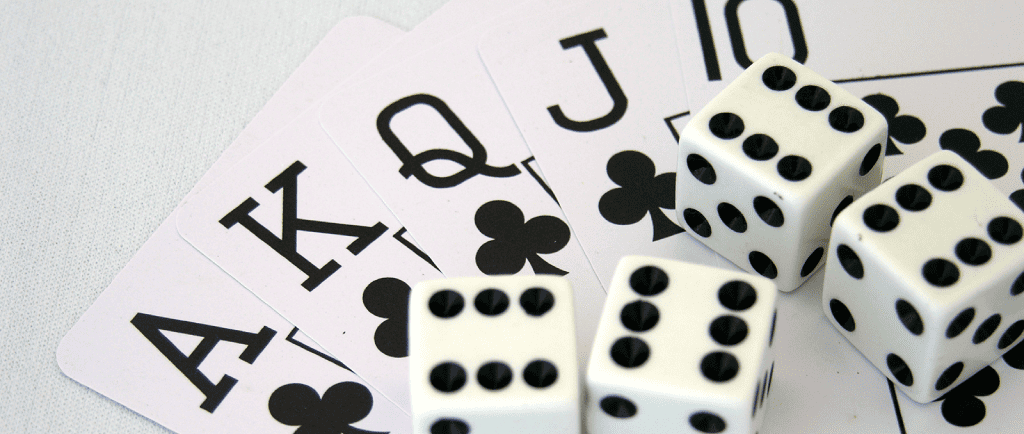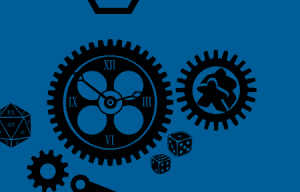
Many of you will be thinking right now, “…but wait…isn’t artificial intelligence only used in computers?” Depends on your definition. AI, to me, is any set of rules that allows a system to make decisions on its own without human input. Computer games with pre-programmed monsters who follow your every move and trail along behind you are following a pattern determined by AI. It may not be a pre-programmed path, but depend instead on responding to your own decisions. Based on real-time input, it alters its own actions.
AI IN BOARDGAMES
So how does this appear in boardgames? Some boardgames allow creatures to move based on simple directions (hug the left wall, move 1 space per turn) with the input being “a new turn”. One creature in Wiz-War depends on players entering its line-of-sight (Fire Imp – old edition) to trigger its own action. This is AI in board games at its simplest. There is an input (turn change, player action), then a variable response from the creature/tool/deck/payout or whatever based on the new input.
In one game design (unpublished) I circumvented the need for a creature AI merely by letting the players move the monsters toward the opponents or their own heroes toward the monsters. I can’t really call this an AI; the players are the active intelligence in such a scheme. But it was a workaround to avoid complicated AI monster movement and action rules. This is a fairly common workaround in game AI; if you really want it to be intelligent, let the player on your right act as your nemesis on your turn.
So what’s this article about? I’d like to take a quick review of a number of AI schemes that various designers have used, techniques to let the game-board make the decisions. This should, hopefully, give you some game design ideas of your own.
AI LEVELS
AI in board games functions at two levels;
One, it’s just a set of programmed instructions that lets the board do things autonomously, as with the boulder and crushing walls in Adventurers: The Temple of Chac, and the mummy movement in Adventurers: The Pyramid of Horus. The board doesn’t really interact with the player actions; you just don’t want to be standing in the wrong place when things start happening.

At the second level of AI, the AI responds to player actions, as with Fearsome Floors, where the player movement actually changes the decisions of the monsters moving around the board, or with Zombicide, where the Zombies chase you down, attack you, split up in groups, or pay attention to the level of noise you’re making. One can easily argue that the first level of preprogrammed, non-responsive actions are just rules, and not AI at all, and I mostly agree. An AI should, at some level, be responding to the player’s actions. But I’ve included both types here just for the sake of completeness (like including soda at a wine-tasting event).
Note that almost all cooperative games require some sort of AI mechanism to create and operate the opposition forces if they wish to avoid the use of a “game master” to run the scenario.
Let’s look at some of the techniques designers have used:
1. AUTONOMOUS RULE MECHANISMS
Game rules feature some autonomous mechanism that allows things to change in the game without any player input, like moving a mummy or slaver along a fixed path, sometimes with die rolls to randomize direction or action (used in Adventurers, Freedom: The Underground Railroad, Break The Safe, Kill Doctor Lucky, Castle Panic, Dice Crawl, etc.).

2. CARD SUBROUTINES
Cards that create a little subroutine of action to be followed, usually creating or activating a monster or other attacker, providing instructions on how the creature, spaceship, or fighter is supposed to act. This isn’t significantly different from #1, but is provided in bite-sized pieces on cards instead of a big fiddly rule book. (used in Battlestar Galactica as Crisis cards, in Castle Ravenloft, and in Wiz-War)
3. ACTIVE RESPONSE
Game rules that allow the creatures on the board to actively respond to a player action (what I’ve been calling “level 2” AI). You move, they follow. (used in Fearsome Floors and Zombicide and Wiz-War)
4. DUMMY PLAYERS
Fresco, 7 Wonders, Bridge, Poker, Alhambra and Tokaido – these offer dummy players; artificial players that tend to take somewhat random actions, but allow you to play a game that should really have one more player than you have. Sometimes it adds an unknown element to what could be a fairly deterministic game. It’s only embarrassing when the dummy wins. Some games duplicate this with “robotic players”, as with Race for the Galaxy: The Gathering Storm and Power Grid: The Robots.
AI POTENTIAL
AI in board games is obviously not needed to make a great game. The large majority of games use none at all; the AI in the game is just your human opponent. But it is a handy tool for game designers to keep in their kits. It would be interesting to play a game with a seriously powerful AI in it that doesn’t require turning on a computer. Can you imagine a game of Berserker where the Berserker is an AI that draws a new card each turn, and each card is a set of additional reactive instructions? Don’t you want to just go design a variant of that right now?
I think the concept of AI delivered by card text is underexplored. AI cards could control board movement in a tactical game; something like having a random robot in Roborally programmed by a randomly selected card hand, or a wargame where each action by the enemy is controlled by card directions drawn from a deck. You might have to pump up that enemy’s strength to offset its stupidity, however.
STORY OF A WISE-ASS ROBOT
The idea of games merged with AI has always fascinated me. In a story I had published this year by Fox and Raven called Paper Man, I explored the question of whether an artificial intelligence could actually arise from a board game. The story follows a wise-ass robot dealing with his own AI issues as he becomes intrigued by this bizarre game. Not to toot my own horn, but I really like how the story came out and would encourage everyone to go out and spend their hard-earned $0.99 to read it. Toot!
Thanks for Kelsey Domeny, Luke Laurie, Brad Brooks and Norv Brooks for recommending a variety of games mentioned in this article.







